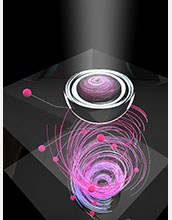Multimedia Gallery
Solar energy conversion breakthrough
An artist’s concept of optically-generated, non-thermalized electrons and their collection in a ferroelectric crystal. An intense screening field results in impact ionization, enabling an unexpectedly high conversion efficiency.
More about this image
Designers of solar cells may soon be setting their sights higher as a discovery by a team of researchers that included scientists from Drexel University, the Shubnikov Institute of Crystallography of the Russian Academy of Sciences, the University of Pennsylvania and the U.S. Naval Research Laboratory revealed a class of materials that could be better at converting sunlight into energy than those currently being used in solar arrays.
Their research shows how a material can be used to extract power from a small portion of the sunlight spectrum with a conversion efficiency that is above its theoretical maximum--a value called the Shockley-Queisser limit. This finding, which could lead to more power-efficient solar cells, was seeded in a near-half-century-old discovery by Russian physicist Vladimir M. Fridkin, Ph.D., a visiting professor of physics at Drexel University, who is also known as one of the innovators behind the photocopier.
A paper published about their research explains how they were able to use a barium titanate crystal to convert sunlight into electric power much more efficiently than the Shockley-Queisser limit would dictate for a material that absorbs almost no light in the visible spectrum--only ultraviolet.
The research was supported in part by the National Science Foundation.
To learn more about this research, see the Drexel news story Mutant chronicles--the quest for a better red-fluorescent protein. (Date image taken: August 2016; date originally posted to NSF Multimedia Gallery: May 31, 2017)
Credit: Drexel University/Ella Marushcenko
Images and other media in the National Science Foundation Multimedia Gallery are available for use in print and electronic material by NSF employees, members of the media, university staff, teachers and the general public. All media in the gallery are intended for personal, educational and nonprofit/non-commercial use only.
Images credited to the National Science Foundation, a federal agency, are in the public domain. The images were created by employees of the United States Government as part of their official duties or prepared by contractors as "works for hire" for NSF. You may freely use NSF-credited images and, at your discretion, credit NSF with a "Courtesy: National Science Foundation" notation.
Additional information about general usage can be found in Conditions.
Also Available:
Download the high-resolution TIF version of the image. (1.4 MB)
Use your mouse to right-click (Mac users may need to Ctrl-click) the link above and choose the option that will save the file or target to your computer.

